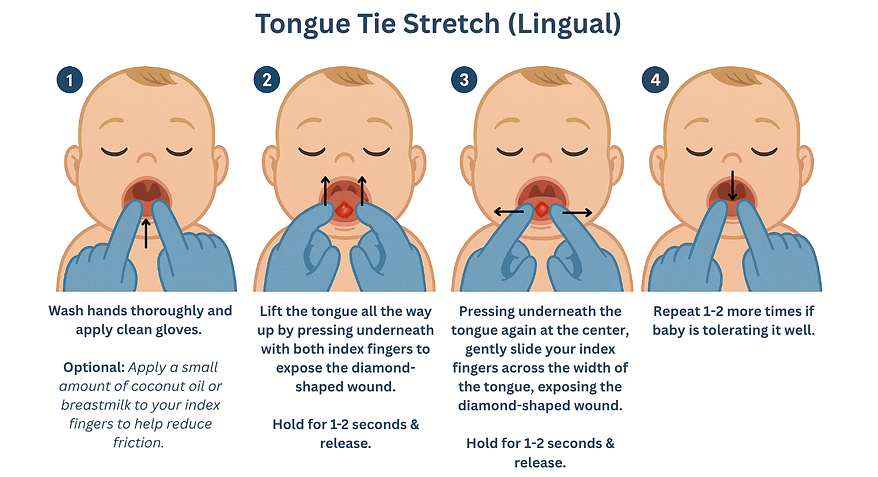Post-Procedure Care
Download our Home
Reference Guide.
What to Expect After the Procedure
Most patients experience only minimal discomfort and recover quickly, but consistent aftercare is essential for a lower risk of reattachment. Most infants will nurse immediately after or as soon as the topical numbing cream wears off (15-30 minutes). We recommend trying to nurse immediately after the procedure, as this can be soothing for newborns and helps us determine what further steps are needed. They may or may not latch right away, or there may still be a painful latch. It may take time to retrain the infants sucking patterns. Don't be discouraged, but let the provider know before leaving. OMT, Bodywork, SLP, or Lactation follow-up may be needed. Some mothers and infants do experience immediate relief, especially if done as soon as possible after birth and diagnosis.
Reattachment risk is significantly reduced with the use of a Co2 Diode Laser, but proper aftercare adherence is essential. Please plan for 4-6 weeks of oral stretches and repeat visits to our office for follow-up or referrals. Reattachment is normal, but it's risk can be reduced. The mouth tends to heal quickly, and reattachment relies heavily on the patient's cooperation and adherence to the aftercare protocols. With its multi-factorial nature, reattachment can occur, and symptoms may remain even if best-practice is observed. That is why at JPFM, we encourage repeat visits after the procedure. The best outcome is one where all systems of the body are addressed, not just the frenulum.
Normal things you may notice after the procedure:
-
A diamond-shaped wound under the tongue or lip
-
Mild fussiness or disrupted sleep for 24–48 hours
-
Slight swelling or white/yellow healing tissue (this is not infection)
-
Temporary feeding challenges as your baby learns new movement patterns
If feeding challenges or pain persist longer than a few days, schedule a visit with us. Your baby may need further follow-up support.
Healing from a frenectomy is usually smooth, but if something doesn’t feel right, we want to hear from you.
Aftercare at a Glance
Important:
Your baby may need time to adjust to new oral movements.
Expect:
-
Temporary fatigue or frustration during nursing, bottle feeds, and stretches.
-
More frequent or shorter feeds
-
New muscle patterns that need time to develop
Pain Management
-
Comfort nursing and skin-to-skin contact.
-
Arnica Pellets (homeopathic) or Infant Tylenol. (speak with your provider about dose)
(Dose:______) (Dose:_____)
-
Breastmilk, cold washcloths, or chilled pacifiers may offer relief.
Wound Care & Oral Stretches
To prevent the tissue from reattaching, stretching exercises are critical.
Begin stretches the morning after the procedure. Continue for 4–6 weeks.
Stretching Schedule:
-
6 times per day (including once overnight if possible)
-
Space out every 4–5 hours (e.g., early morning, late morning, afternoon, evening, bedtime, overnight)
💡 Be gentle but firm. The goal is to prevent the healing tissue from sticking back together.
Additional Support:
We encourage incorporating lactation, OMT, chiropractic care, or SLP into your aftercare
depending on your needs. Call us if you notice any remaining symptoms or issues.
Signs to Watch For
Contact us if you notice:
-
Excessive bleeding
-
Signs of infection (fever, pus, foul odor)
-
Refusal to feed for more than 8 hours
-
Poor urine output (<4 wet diapers in 24 hrs)
Call our office at 260-436-7722 or our after-hours emergency line at 260-241-0655
Leave a message, and we will get back to you as soon as possible!
.png)

Osteopathic Manipulative Treatment
for Tongue Ties
We usually recommend Osteopathic Manipulative Treatment (OMT) be scheduled for a couple of days post-frenectomy. OMT is a gentle, hands-on therapy that helps the body self-regulate and heal by addressing structural imbalances, tension patterns, and restrictions. It’s particularly useful for infants as tongue-tie, feeding issues, and body dysregulation usually go hand-in-hand, especially after traumatic births. It is common to feel subtle shifts in tension and improvements immediately after a session. It is also normal to feel some muscle soreness. These responses are part of the body’s natural recalibration process. OMT has been shown it can improve the overall outcome of tongue and lip tie releases. We are excited to have our own Dr. Vijay Veerula offer this service in the office during your follow-up to improve outcomes for our patients.
What to Expect After OMT
Everyone responds differently, but you may notice:
-
Increased relaxation or fatigue
-
Mild soreness or body awareness
-
Digestive shifts (e.g., gurgling belly, increased bowel movements)
-
Emotional release or changes in mood
-
Improved sleep or restlessness for 24–48 hours
These effects typically resolve within 1–3 days. They are signs of your body adjusting and should not be a cause for concern.
For Infants & Children
With OMT incorporated into your aftercare, you may see:
-
Improved latch, feeding, or digestion
-
More relaxed sleep
-
Easier tummy time or head-turning
-
Reduced congestion or reflux symptoms
Learn more about OMT and how it can help: HERE
or call
260-436-7722
📍 Jefferson Pediatrics & Family Medicine
3919 W Jefferson Blvd, Fort Wayne, IN
You’re not alone—we’re here to support you through every step of your health journey.
.png)
.png)
